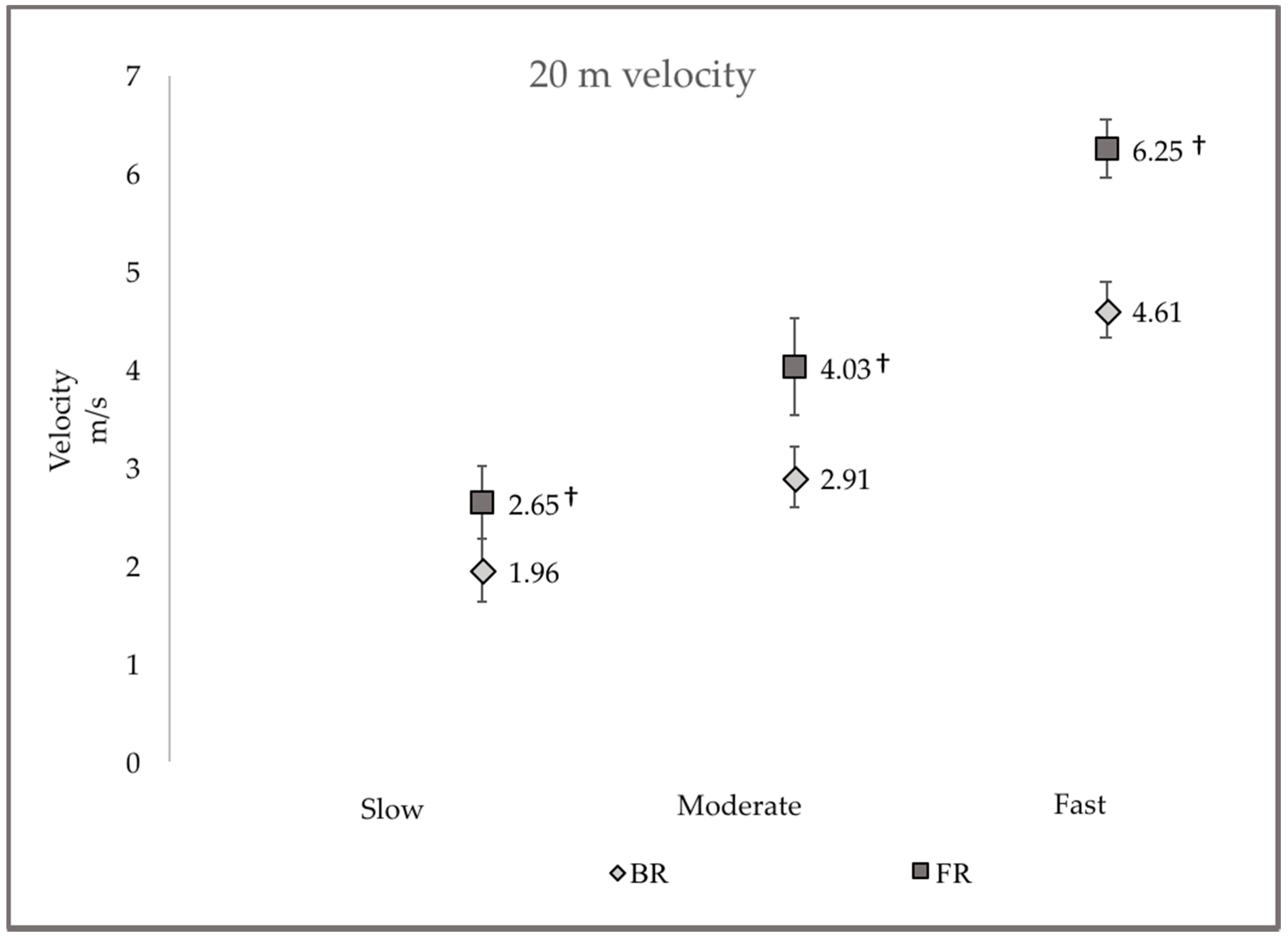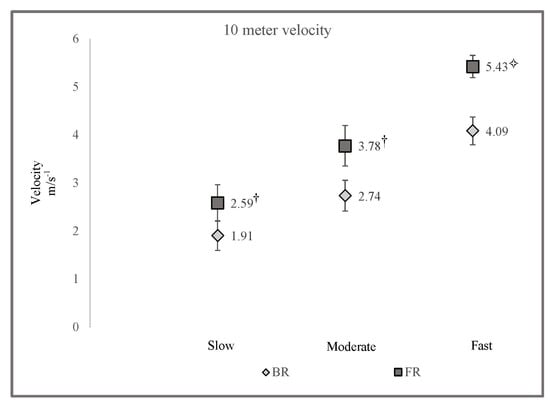Prescribing Target Running Intensities for High-School Athletes: Can Forward and Backward Running Performance Be Autoregulated?
Abstract
1. Introduction
2. Materials and Methods
2.1. Participants
2.2. Measures
2.3. Design and Procedures
2.4. Statistical Analysis
3. Results
4. Discussion
5. Conclusions
Author Contributions
Funding
Acknowledgments
Conflicts of Interest
References
- LaBella, C.R.; Huxford, M.R.; Grissom, J.; Kim, K.Y.; Peng, J.; Christoffel, K.K. Effect of neuromuscular warm-up on injuries in female soccer and basketball athletes in urban public high school. Arch. Pediatr. Adolesc. Med. 2011, 165, 1033–1040. [Google Scholar] [CrossRef] [PubMed]
- Bompa, T.O. Total Training for Young Champions; Human Kinetics: Champaign, IL, USA, 2000; p. 211. [Google Scholar]
- Haugen, T.; Tonnessen, E.; Leirstein, S.; Hem, E.; Seiler, S. Not quite so fast: Effect of training at 90% sprint speed on maximal and repeated-sprint ability in soccer players. J. Sports Sci. 2014, 32, 1979–1986. [Google Scholar] [CrossRef] [PubMed]
- Heiderscheit, B.C.; Sherry, M.A.; Silder, A.; Chumanov, E.S.; Thelen, D.G. Hamstring strain injuries: Recommendations for diagnosis, rehabilitation, and injury prevention. J. Orthop. Sports Phys. Ther. 2010, 40, 67–81. [Google Scholar] [CrossRef] [PubMed]
- Perrier, E.T.; Pavol, M.J.; Hoffman, M.A. The acute effects of a warm-up including static or dynamic stretching on countermovement jump height, reaction time, and flexibility. J. Strength Cond. Res. 2011, 25, 1925–1931. [Google Scholar] [CrossRef] [PubMed]
- Lockie, R.G.; Murphy, A.J.; Schultz, A.B.; Knight, T.J.; de Jonge, X.A.J. The effects of different speed training protocols on sprint acceleration kinematics and muscle strength and power in field sport athletes. J. Strength Cond. Res. 2012, 26, 1539–1550. [Google Scholar] [CrossRef] [PubMed]
- Abbiss, C.R.; Laursen, P.B. Describing and understanding pacing strategies during athletic competition. Sports Med. 2008, 38, 239–252. [Google Scholar] [CrossRef] [PubMed]
- Francis, C. Training for Speed; Faccioni Speed and Conditioning Consultant: Canberra, Australia, 1997. [Google Scholar]
- Gambetta, V. Athletic Development: The Art & Science of Funcitonal Sports Conditioning; Human Kinetics: Champaign, IL, USA, 2007. [Google Scholar]
- Arazi, H.; Keihaniyan, A.; EatemadyBoroujeni, A.; Oftade, A.; Takhsha, S.; Asadi, A.; Ramirez-Campillo, R. Effects of hear rate vs. speed-based high intensity interval training on aerobic and anaerobic capacity of female soccer players. Sports 2017, 5, 57. [Google Scholar] [CrossRef] [PubMed]
- Gabbett, T.J. Physiological characteristics of junior and senior rugby league players. Br. J. Sports Med. 2002, 36, 334–339. [Google Scholar] [CrossRef] [PubMed]
- Oliver, J.; Williams, A.C.; Armstrong, N. Reliability of a Field and Laboratory Test of Repeated Sprint Ability. Pediatr. Exerc. Sci. 2006, 18, 339–350. [Google Scholar] [CrossRef]
- Bates, B.T.; Morrison, E.; Hamill, J. A comparison between forward and backward running. In The 1984 Olympic Scientific Congress Proceedings: Biomechanics; Microform Publications: Eugene, OR, USA, 1984. [Google Scholar]
- Gravina, L.; Gil, S.M.; Ruiz, F.; Zubero, J.; Gil, J.; Irazusta, J. Anthropometric and physiological differences between first team and reserve soccer players aged 10–14 years at the beginning and end of the season. J. Strength Cond. Res. 2008, 22, 1308–1314. [Google Scholar] [CrossRef] [PubMed]
- Rebelo, A.; Brito, J.; Seabra, A.; Oliveira, J.; Krustrup, P. Physical match performance of youth football players in relation to physical capacity. Eur. J. Sport Sci. 2014, 14, S148–S156. [Google Scholar] [CrossRef] [PubMed]
- Uthoff, A.; Oliver, J.; Cronin, J.; Harrison, C.; Winwood, P. A new direction to athletic performance: Understanding the acute and longitudinal responses to backward running. Sports Med. 2018, 48, 1083–1096. [Google Scholar] [CrossRef] [PubMed]
- Weyand, P.G.; Sandell, R.F.; Prime, D.N.; Bundle, M.W. The biological limits to running speed are imposed from the ground up. J. Appl. Physiol. 2010, 108, 950–961. [Google Scholar] [CrossRef] [PubMed]
- Wright, S.; Weyand, P.G. The application of ground force explains the energetic cost of running backward and forward. J. Exp. Biol. 2001, 204, 1805–1815. [Google Scholar] [PubMed]
- Mehdizadeh, S.; Arshi, A.R.; Davids, K. Quantifying coordination and coordination variability in backward versus forward running: Implications for control of motion. Gait Posture 2015, 42, 172–177. [Google Scholar] [CrossRef] [PubMed]
- Van den Tillar, R.; Lerberg, E.; Von Heimburg, E. Comparison of three types of warm-up upon sprint ability in experienced soccer players. J. Sport Health Sci. 2016, 30, 2258–2265. [Google Scholar] [CrossRef]
- Mirwald, R.L.; Baxter-Jones, A.D.; Bailey, D.A.; Beunen, G.P. An assessment of maturity from anthropometric measures. Med. Sci. Sports Exerc. 2002, 34, 689–694. [Google Scholar] [PubMed]
- Soligard, T.; Myklebust, G.; Steffen, K.; Holme, I.; Silvers, H.; Bizzini, M.; Junge, A.; Dvorak, J.; Bahr, R.; Andersen, T.E. Comprehensive warm-up programme to prevent injuries in young female footballers: Cluster randomised controlled trial. Br. Med. J. 2008, 337, 1–9. [Google Scholar] [CrossRef] [PubMed]
- Hopkins, W.G. A New View of Statistics. Available online: http://sportsci.org/resource/stats/ (accessed on 8 August 2018).
- Koo, T.K.; Li, M.Y. A guideline of selecting and reporting intraclass correlation coefficients for reliability research. J. Chiropr. Med. 2016, 15, 155–163. [Google Scholar] [CrossRef] [PubMed]
- Lloyd, R.S.; Oliver, J.L.; Hughes, M.G.; Williams, C.A. Reliability and validity of field-based measures of leg stiffness and reactive strength index in youths. J. Sports Sci. 2009, 27, 1565–1573. [Google Scholar] [CrossRef] [PubMed]
- Buchheit, M.; Mendez-Villanueva, A. Reliability and stability of anthropometric and performance measures in highly-trained young soccer players: Effect of age and maturation. J. Sports Sci. 2013, 31, 1332–1343. [Google Scholar] [CrossRef] [PubMed]
- Cronin, J.B.; Templeton, R.L. Timing light height affects sprint times. J. Strength Cond. Res. 2008, 22, 318–320. [Google Scholar] [CrossRef] [PubMed]
- Quatman-Yates, C.C.; Quatman, C.E.; Meszaros, A.J.; Paterno, M.V.; Hewett, T.E. A systematic review of sensorimotor function during adolescence: A developmental stage of increased motor awkwardness? Br. J. Sports Med. 2012, 46, 649–655. [Google Scholar] [CrossRef] [PubMed]
- Gerodimos, V.; Zafeiridis, A.; Perkos, S.; Dipla, K.; Manou, V.; Kellis, S. The contribution of stretch-shortening cycle and arm-swing performance in children, adolescents, and adult basketball players. Pediatr. Exerc. Sci. 2008, 20, 379–389. [Google Scholar] [CrossRef] [PubMed]
- Hopkins, W.G. Measures of reliability in sports medicine and science. Sports Med. 2000, 30, 1–15. [Google Scholar] [CrossRef] [PubMed]
- Little, T.; Williams, A.G. Sutability of soccer training drills for endurance training. J. Strength Cond. Res. 2006, 20, 316–319. [Google Scholar] [CrossRef] [PubMed]
- Meylan, C.; Cronin, J.; Oliver, J.; Hughes, M. Talent identification in soccer: The role of maturity status on physical, physiological and technical characteristics. Int. J. Sports Sci. Coach. 2010, 5, 571–592. [Google Scholar] [CrossRef]
- Arata, A. Kinematic and Kinetic Evaluations of High Speed Backward Running; Department of Exercise and Movement Science: Eugene, OR, USA, 1999; p. 119. [Google Scholar]
- Mattson, M.P. Evolutionary aspects of human exercise—Born to run purposefully. Ageing Res. Rev. 2012, 11, 347–352. [Google Scholar] [CrossRef] [PubMed]
- Cavagna, G.A.; Legramandi, M.A.; La Torre, A. Running backwards: Soft landing-hard takeoff, a less efficient rebound. Proc. Biol. Sci. 2011, 278, 339–346. [Google Scholar] [CrossRef] [PubMed]
- Hoogkamer, W.; Meyns, P.; Duysens, J. Steps forward in understanding backward gait: From basic circuits to rehabilitation. Exerc. Sports Sci. Rev. 2014, 42, 23–29. [Google Scholar] [CrossRef] [PubMed]
- Rumpf, M.C.; Cronin, J.B.; Mohamad, I.N.; Mohamad, S.; Oliver, J.; Hughes, M. Acute effects of sled towing on sprint time in male youth of different maturity status. Pediatr. Exerc. Sci. 2014, 26, 71–75. [Google Scholar] [CrossRef] [PubMed]


| Variable | Day 1 (m ± sd) | Day 2 (m ± sd) | Day 3 (m ± sd) | % Change in Mean | CV | ICC | |||
|---|---|---|---|---|---|---|---|---|---|
| Day 1–2 (95% CL) | Day 2–3 (95% CL) | Day 1–2 (95% CL) | Day 2–3 (95% CL) | Day 1–2 (95% CL) | Day 2–3 (95% CL) | ||||
| 10 m | |||||||||
| Slow forward (ms−1) | 2.70 ± 0.40 | 2.53 ± 0.41 | 2.54 ± 0.31 | −6.15 (−11.3 to 0.75) | 0.65 (−1.43 to 2.78) | 12.0 (9.58 to 16.09) | 4.33 (3.48 to 5.47) | 0.45 (0.14 to 0.68) | 0.93 (0.82 to 0.95) |
| Slow backward (ms−1) | 1.96 ± 0.33 | 1.87 ± 0.30 | 1.89 ± 0.29 | −3.98 (−7.88 to 0.08) | 1.07 (2.96 to 1.87) | 8.75 (7.00 to 11.68) | 3.82 (3.07 to 5.06) | 0.75 (0.56 to 0.87) | 0.94 (0.88 to 0.97) |
| Moderate forward (ms−1) | 3.70 ± 0.49 | 3.84 ± 0.36 | 3.80 ± 0.39 | 4.40 (0.41 to 8.54) | −1.25 (−3.04 to 0.57) | 8.21 (6.57 to 10.94) | 3.78 (3.06 to 5.00) | 0.56 (0.28 to 0.75) | 0.87 (0.76 to 0.93) |
| Moderate backward (ms−1) | 2.67 ± 0.32 | 2.81 ± 0.33 | 2.75 ± 0.30 | 5.27 ✧ (1.74 to 8.93) | −1.25 (−3.44 to −0.33) | 7.16 (5.74 to 9.53) | 3.26 (2.62 to 4.32) | 0.67 (0.43 to 0.82) | 0.92 (0.85 to 0.96) |
| Fast forward (ms−1) | 5.38 ± 0.28 | 5.45 ± 0.22 | 5.45 ± 0.20 | 1.49 (−0.23 to 3.24) | −0.13 (−0.74 to 0.50) | 3.52 (2.83 to 4.66) | 1.24 (1.00 to 1.64) | 0.48 (0.18 to 0.70) | 0.90 (0.81 to 0.95) |
| Fast backward (ms−1) | 4.02 ± 0.32 | 4.11 ± 0.28 | 4.13 ± 0.27 | 2.36 ✧ (0.95 to 3.78) | 0.34 (−0.36 to 1.04) | 2.85 (2.29 to 3.76) | 1.42 (1.14 to 1.87) | 0.87 (0.75 to 0.93) | 0.96 (0.92 to 0.98) |
| 20 m | |||||||||
| Slow forward (ms−1) | 2.72 ± 0.41 | 2.63 ± 0.40 | 2.60 ± 0.31 | −3.57 (−8.39 to 1.51) | −0.75 (−2.76 to 1.3) | 10.95 (8.74 to 14.66) | 4.24 (3.40 to 5.61) | 0.52 (0.23 to 0.73) | 0.91 (0.82 to 0.95) |
| Slow backward (ms−1) | 1.99 ± 0.35 | 1.94 ± 0.22 | 1.94 ± 0.25 | −2.06 (−6.12 to 2.16) | 0.20 (−1.54 to 1.98) | 8.92 (7.14 to 11.91) | 3.63 (2.92 to 4.81) | 0.70 (0.48 to 0.84) | 0.92 (0.85 to 0.96) |
| Moderate forward (ms−1) | 3.94 ± 0.57 | 4.12 ± 0.43 | 4.04 ± 0.47 | 5.05 (0.96 to 9.30) | −2.18 (−4.03 to −0.30) | 8.38 (6.70 to 11.17) | 3.63 (3.17 to 5.23) | 0.63 (0.37 to 0.80) | 0.89 (0.79 to 0.94) |
| Moderate backward (ms−1) | 2.83 ± 0.38 | 2.98 ± 0.37 | 2.92 ± 0.36 | 5.59 ✧ (2.06 to 9.24) | −2.18 ✧ (−3.64 to 0.70) | 7.14 (5.72 to 9.50) | 3.09 (2.49 to 4.09) | 0.72 (0.51 to 0.85) | 0.94 (0.89 to 0.97) |
| Fast forward (ms−1) | 6.23 ± 0.33 | 6.26 ± 0.28 | 6.26 ± 0.27 | 0.57 (−0.64 to 1.79) | −0.05 (−0.54 to 0.44) | 2.48 (1.99 to 3.27) | 1.00 (0.81 to 1.32) | 0.76 (0.57 to 0.87) | 0.95 (0.91 to 0.98) |
| Fast backward (ms−1) | 4.55 ± 0.40 | 4.64 ± 0.36 | 4.65 ± 0.35 | 2.16 ✧ (0.85 to 3.49) | 0.15 (−0.32 to 0.64) | 2.66 (2.14 to 3.51) | 0.99 (0.80 to 1.30) | 0.91 (0.82 to 0.95) | 0.99 (0.97 to 0.99) |
© 2018 by the authors. Licensee MDPI, Basel, Switzerland. This article is an open access article distributed under the terms and conditions of the Creative Commons Attribution (CC BY) license (http://creativecommons.org/licenses/by/4.0/).
Share and Cite
Uthoff, A.; Oliver, J.; Cronin, J.; Winwood, P.; Harrison, C. Prescribing Target Running Intensities for High-School Athletes: Can Forward and Backward Running Performance Be Autoregulated? Sports 2018, 6, 77. https://doi.org/10.3390/sports6030077
Uthoff A, Oliver J, Cronin J, Winwood P, Harrison C. Prescribing Target Running Intensities for High-School Athletes: Can Forward and Backward Running Performance Be Autoregulated? Sports. 2018; 6(3):77. https://doi.org/10.3390/sports6030077
Chicago/Turabian StyleUthoff, Aaron, Jon Oliver, John Cronin, Paul Winwood, and Craig Harrison. 2018. "Prescribing Target Running Intensities for High-School Athletes: Can Forward and Backward Running Performance Be Autoregulated?" Sports 6, no. 3: 77. https://doi.org/10.3390/sports6030077
APA StyleUthoff, A., Oliver, J., Cronin, J., Winwood, P., & Harrison, C. (2018). Prescribing Target Running Intensities for High-School Athletes: Can Forward and Backward Running Performance Be Autoregulated? Sports, 6(3), 77. https://doi.org/10.3390/sports6030077







